Cell Transport ‘Traffic Jam’ Caused by Mutated Protein, Researchers Discover

A mutated form of the huntingtin (mHTT) protein has been acknowledged as the cause of Huntington’s disease, but researchers have not been fully clear about how it disrupts the function of brain cells.
A study, “Mutant Huntingtin Disrupts the Nuclear Pore Complex,” that was published in the scientific journal Neuron provides new knowledge that can help scientists understand not only the underlying mechanisms of Huntington’s disease, but also several other neurological diseases, including amyotrophic lateral sclerosis (ALS).
According to recent findings, mHTT impairs processes of cellular transport, contributing to neurotoxicity that leads to the death of neurons.
“This significantly expands our understanding of Huntington’s disease pathology, and the pathology of diseases that are similar to Huntington’s disease, and even what we see in aging,” Charbel Moussa, director of the Translational Neurotherapeutics Program at Georgetown University Medical Center, said in a press release. “We’re still, unfortunately, far from a cure.”
To function normally, a cell requires transporting several elements from its central operations area, the nucleus, to all other parts of the cell, and vice-versa.
Researchers from Johns Hopkins University School of Medicine, in collaboration with investigators from the University of Florida and the University of California, Irvine, have demonstrated that mHTT plays an active role in disrupting this cellular transport system.
Making use of mouse and fly Huntington’s experimental models, as well as human stem cells and human tissue samples, they observed that mHTT forms aggregates in the nucleus, making it unable to pass through the existing passages called nuclear pores. This accumulation of mHTT and the consequent blockage of the nuclear passages causes brain cells to shut down and eventually die.
“We found these kind of traffic jams in cells, and if we can fix the traffic jams we can potentially provide a new avenue for treatment of neurodegenerative disease,” said Jonathan Grima, first author of the study.
Previous studies have showed that results obtained with mouse models are not always comparable to those seen in humans. However, the use of several experimental Huntington’s disease models complemented by human samples provided additional support to these findings, said George Yohrling, PhD, senior director of mission and scientific affairs at the Huntington’s Disease Society of America.
Although this research is still in early stages, the team believes these findings may help develop new methods to tackle Huntington’s and support the search for new therapies.
“This is very exciting research because we didn’t know what mutant genes or proteins were doing in the body, and this points to new areas to target research,” Yohrling said. “Scientists, biotech companies and pharmaceutical companies could capitalize on this and maybe develop therapies for this biological process.”






